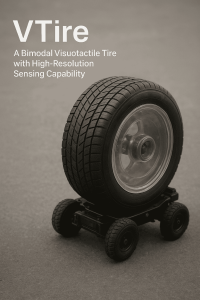VTire is a groundbreaking “smart tire” that merges tactile and visual sensing a first in tire technology aiming to enhance the adaptability and environmental awareness of wheeled robots and vehicles. The system delivers capabilities such as terrain recognition, crack detection, load sensing, and tire damage detection, significantly extending beyond the limitations of conventional tire sensing.

This smart tire achieves a rare combination of mechanical strength and optical clarity through optimized material selection and structural design.
Hardware Design & Construction
-
Sensing Skin Layers:
-
An inner transparent polyurethane (PU) hub offers elasticity, toughness, and transparency.
-
A soft outer layer of low-hardness elastic silicone surrounds the hub.
-
A reflective coating composed of Eco-Flex 30 with silver powder enhances optical feedback.
-
PVA (Polyvinyl alcohol) is used as a soluble internal mold during fabrication for easier demolding.
-
-
Imaging Setup:
-
A binocular depth camera (Intel RealSense D405) is mounted within the hub to capture high-fidelity deformation patterns and textures in real time.
-
A bearing-and-bracket mechanism ensures the camera remains stationary relative to the tire itself.
-
A hollow motor shaft allows USB wiring to pass through seamlessly.
-
-
Illumination:
-
Uniform lighting is delivered by LED rings placed around the tire’s inner circumference, improving sensor accuracy.
-
Software & Sensing Algorithms
-
Transformer-Based Multimodal Classification:
-
The system processes tactile and visual data through dedicated modality encoders.
-
LayerNorm normalizes the fragment features, while self-attention and cross-attention enable deep fusion of tactile and visual modalities.
-
The output is utilized for terrain classification, crack detection, and more.
-
-
Load Detection via Finite Element Analysis (FEA):
-
FEA-based modeling allows the tire to infer applied load by analyzing how the materials deform under stress.
-
-
Contact Segmentation Algorithm:
-
Capable of segmenting and identifying points of contact between tire and terrain, facilitating accurate detections of cracks, objects, or anomalies.
-
Experimental Platform & Dataset
-
A fully functional mobile platform equipped with VTire was assembled to conduct real-world testing.
-
The system was evaluated across complex terrains, with extensive visual and tactile datasets gathered and now made publicly available.
-
Hardware, algorithms, and datasets are open-source, enabling researchers and developers to replicate and expand upon the work.
Performance Highlights
| Metric | Achievement |
|---|---|
| Terrain Classification | 99.2% accuracy |
| Tire Damage Detection | 97% accuracy |
| Object Search Success | 98% |
| Load Capacity | Withstands > 35 kg |
These results demonstrate robust sensor fusion, reliability in complex conditions, and physical resilience.
Summary: Why VTire Matters
-
Bimodal Sensing Innovation: Seamlessly integrates touch and vision into a single tire unit, enabling real-time, high-resolution terrain interaction insights.
-
Hardware-Software Synergy: Combines purpose-built transparent materials, depth imaging, and transformer fusion models for robust perception.
-
Validated in the Field: Tested under realistic scenarios with impressive accuracy across multiple detection tasks.
-
Open & Collaborative: Designs and data are open-source, enabling adoption and innovation in both industrial and research domains.